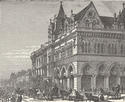 As heavy industry intensified wealth, Glasgow's predominantly classical architecture grew more varied in style. At first Georgian manners prevailed. Both the surprisingly modest Custom House on Clyde Street, and the galleried City Hall on Candleriggs, each 1840, remained restrained and severe. In the same decade municipal administration moved to the City and County Buildings on Wilson Street, by Clarke & Bell, 1844, a more imposing but still Grecian temple front with pilastered flanks.
As heavy industry intensified wealth, Glasgow's predominantly classical architecture grew more varied in style. At first Georgian manners prevailed. Both the surprisingly modest Custom House on Clyde Street, and the galleried City Hall on Candleriggs, each 1840, remained restrained and severe. In the same decade municipal administration moved to the City and County Buildings on Wilson Street, by Clarke & Bell, 1844, a more imposing but still Grecian temple front with pilastered flanks.
 Within a generation, Italianate models were in vogue, first in the General Post Office (1875-76), which played its part in altering the scale and style of George Square, and then, dominating the square from the east, in the City Chambers (1883-88) by William Young. This immense building, third home for Glasgow's expanding administration, faces one of the city's few public open spaces, its wide tiered front accented by a tempietto-topped tower above a pedimented centre with domed cupolas north and south. The facade is full of Venetian Renaissance chiaroscura, artisically distributing light and dark masses in its outside appearance, intimating something of the lavish marbled excesses of the interior.
Within a generation, Italianate models were in vogue, first in the General Post Office (1875-76), which played its part in altering the scale and style of George Square, and then, dominating the square from the east, in the City Chambers (1883-88) by William Young. This immense building, third home for Glasgow's expanding administration, faces one of the city's few public open spaces, its wide tiered front accented by a tempietto-topped tower above a pedimented centre with domed cupolas north and south. The facade is full of Venetian Renaissance chiaroscura, artisically distributing light and dark masses in its outside appearance, intimating something of the lavish marbled excesses of the interior.
 On Buchanan Street, the Stock Exchange by John Burnet (1875) broke from the classical tradition in a unique orgy of French Gothic arcading. On the other hand, in St Andrew's Halls (1873-77), destroyed by fire in 1962, James Sellars re-invoked Grecian norms. The building's extant west front is a masterly street-block parade of giant Ionic columns, each five-bay flank of the facade topped by a raised attic carried on caryatids.
On Buchanan Street, the Stock Exchange by John Burnet (1875) broke from the classical tradition in a unique orgy of French Gothic arcading. On the other hand, in St Andrew's Halls (1873-77), destroyed by fire in 1962, James Sellars re-invoked Grecian norms. The building's extant west front is a masterly street-block parade of giant Ionic columns, each five-bay flank of the facade topped by a raised attic carried on caryatids.
 The Victorian period is also marked by successive bridgings of the Clyde, several of these associated with great railway stations, notably St Enoch (1870s, demolished in 1977) and Central (1899-1908) embedded at the heart of the city.
The Victorian period is also marked by successive bridgings of the Clyde, several of these associated with great railway stations, notably St Enoch (1870s, demolished in 1977) and Central (1899-1908) embedded at the heart of the city.